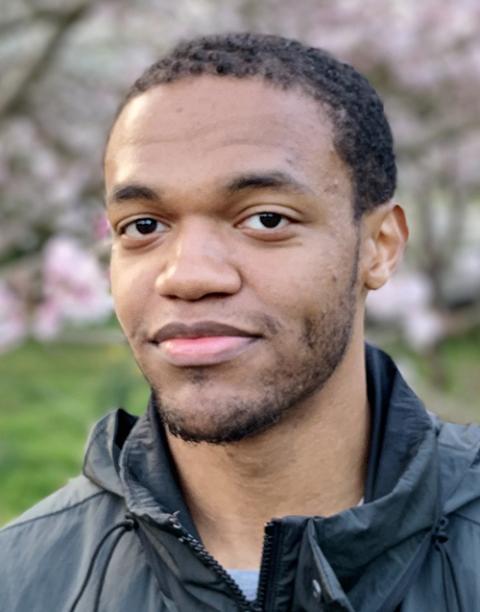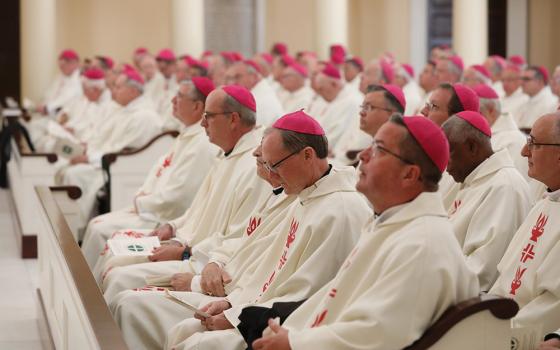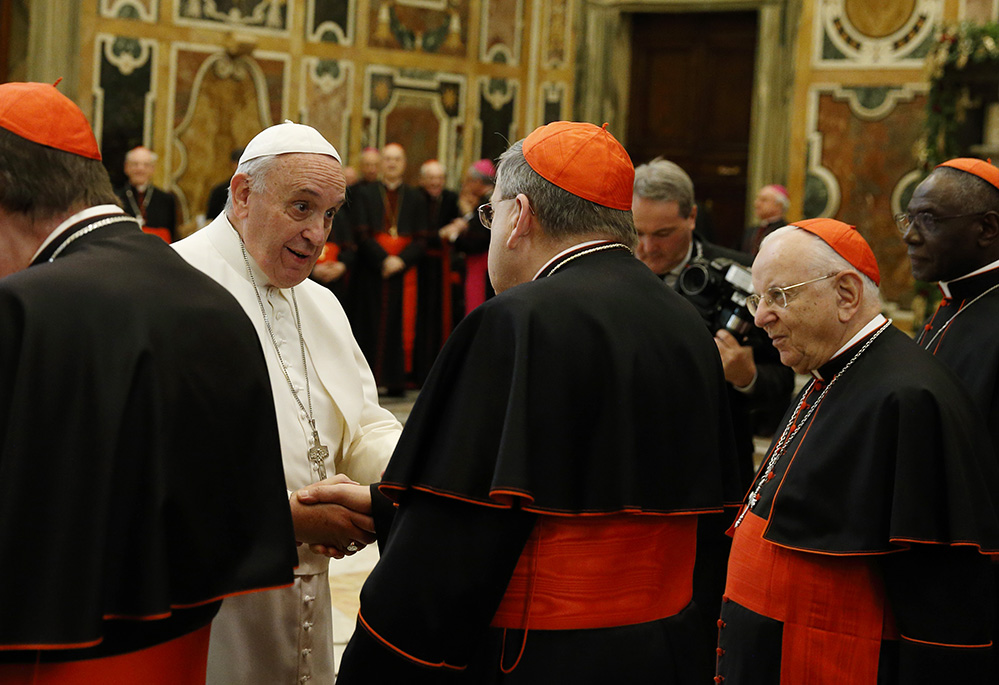
Pope Francis greets U.S. Cardinal Raymond Burke, patron of the Knights and Dames of Malta, during an audience to exchange Christmas greetings with members of the Roman Curia in Clementine Hall at the Vatican Dec. 22, 2014. (CNS/Paul Haring)

The dubia cardinals. The "Pachamama" affair. The Viganò dossier. Regular criticisms of his pontificate on the Eternal Word Television Network.
Pope Francis' 10 years on the chair of St. Peter have been marked in large part by persistent criticisms and tenacious resistance from the conservative wing of the Catholic Church, particularly in the Anglophone world, where formerly ardent papal defenders have lashed out against the current pontiff in ways once thought unthinkable.
"They wanted the church to be a moralizing church, a refuge from modernity, for the church to be a fortress where it issues condemnations and edicts and stands against the so-called progressive agenda," said Christopher Lamb, the Rome correspondent for The Tablet, a British weekly Catholic newspaper.
Lamb, who documented the conservative resistance to Francis in his 2020 book, The Outsider: Pope Francis and His Battle to Reform the Church, told NCR that the pope's critics early on presented their opposition in theological terms, often arguing that Francis' style of pastoral accompaniment sowed "confusion" by not clearly articulating church doctrines on homosexuality, abortion and the indissolubility of marriage.
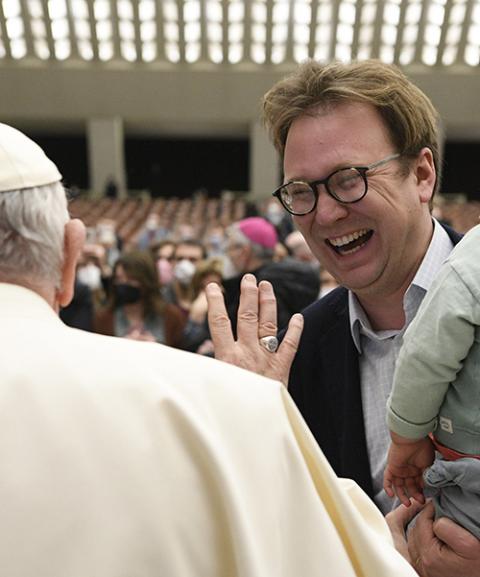
Pope Francis greets Christopher Lamb, Rome correspondent for The Tablet, during a general audience in the Paul VI hall at the Vatican Feb. 16, 2022. (CNS/Vatican Media)
But Lamb said that Francis' vision of the global Catholic Church as a "field hospital," where the Eucharist is understood as medicine for the sick instead of a prize for the perfect, challenged conservative political visions of the church as a combatant in the culture wars that were utilized by the Republican Party in the United States and embraced by populist-nationalist leaders in Europe and South America.
"There have been these political attacks on Francis because he is a leader on the world stage who is making a difference and having an impact, particularly through the media," Lamb said.
Tension from the start
Other observers — including journalists, scholars, theologians and Catholic bloggers who have studied Francis' decadelong pontificate — describe similar dynamics at work. These dynamics, they say, have fueled the conservative pushback against the pope almost since the moment he emerged on the central balcony of St. Peter's Basilica on March 13, 2013, in a white cassock but without the usual gold-embroidered papal stole.
"That scene on the balcony that night immediately indicated to those with eyes to see and ears to hear that this would be a different kind of pontificate," said Nichole Flores, a religious studies professor at the University of Virginia.
Flores told NCR that Francis, by bowing in silence and asking the crowd in St. Peter's Square that night to pray for him, revealed that he would have different priorities as pope than his immediate predecessors, Benedict XVI and John Paul II.
"Perhaps we should have foreseen resistance because of Francis' context coming out of Latin America, that culturally there was going to be resistance to what Francis brought to his pontificate, regardless of what he had to say about particular issues," Flores said.
Nate Tinner-Williams, co-founder and editor of Black Catholic Messenger, told NCR that more conservative U.S. bishops whose vision of the Catholic Church they believed had been vindicated by Benedict and John Paul "were met with surprise when Pope Francis was elected and started doing his thing."
"I think the American bishops see themselves in a position to exercise power and their voices to be influential in a way that for me doesn't seem realistic. I don't know if [the U.S. church is] a particularly powerful or important wing of the church," Tinner-Williams said.
Experts such as Massimo Faggioli, a theologian and church historian at Villanova University, told NCR that Francis embodies for his critics the future of a Catholic Church that has its center of gravity in the global south rather than in its historic home in the Northern Hemisphere.
"Francis is not an extension of Catholic Europe, and this, I believe, is the root of a lot of the tension against Francis," said Faggioli, who added that in 2013 he suspected that a Jesuit pope from Argentina would lead many to feel uncomfortable.
"I expected a different kind of opposition, which would not be disruptive in the sense of doing everything and anything to undermine him," Faggioli said. "What has been surprising has been how precocious his opposition was. It started almost immediately, a few weeks after he was elected."
Within months of Francis' election, criticisms began appearing in conservative Catholic circles after Francis washed the feet of 12 young people, including two women and two Muslims, on Holy Thursday in 2013, and when he sat down for uncensored interviews in publications like America Magazine.
In September 2013, a blogger on the EWTN-owned newspaper National Catholic Register described himself as a member of the "loyal opposition" that found much to critique in Francis' approach. That same year, another conservative Catholic writer said Francis made him "uncomfortable," though he also wrote that perhaps the pontiff, like Jesus, was challenging him and other Catholics to not be complacent.
Conservative hostility takes root
Cathleen Kaveny, a law and theology professor at Boston College, told NCR that Francis unsettled conservative Catholics who saw in John Paul and Benedict a unified vision of the papacy that they believed would "almost continue, ahistorically, throughout time."
"They saw and still see what they perceive as John Paul II's and Benedict's main message as the message that we still need to preach now: the move against the dictatorship of relativism. That's their main concern, holding down the position, defending the rules and seeing the church as a clear community that's different from the broader culture.
"For them, that's the main impetus," Kaveny said, "but that's not the main impetus for Francis."
From 2014 to 2016, experts said, conservative Catholic resistance to Francis began to crystallize, especially in 2015 when the pontiff wrote "Laudato Si', on Care for Our Common Home," his encyclical on environmental issues that acknowledged that fossil fuel emissions are primarily responsible for climate change.
"Laudato Si' spurred objections because the critics saw Francis taking part in globalism and a population control agenda," said Mike Lewis, a former communications official for the U.S. Conference of Catholic Bishops. Lewis founded the Where Peter Is blog in February 2018 to defend Francis from what he saw as a growing chorus of unfair attacks on the pope and his teachings.
Lewis told NCR that conservative-minded Catholics also disliked Evangelii Gaudium ("The Joy of the Gospel"), Francis' 2013 apostolic exhortation, in which he outlined his vision for pastoral accompaniment and emphasized social justice issues, such as economic inequality, that he attributed to unfettered capitalism.
Advertisement
"Rush Limbaugh accused [Francis] of Marxism," Lewis said. "A lot of people and Catholics who were dedicated to capitalism began seeing [Francis] in a negative light."
In 2014 and 2015, Lewis and other observers said, conservative hostility toward Francis took root when the pope convened the Synod of Bishops on the family. The synod featured frank discussions of thorny issues, such as how to minister to families with LGBTQ children and to Catholics who had been divorced and had gotten remarried without first obtaining annulments.
Lamb recalled interviewing U.S. Cardinal Raymond Burke and the late Australian Cardinal George Pell at that synod, and how both of those conservative churchmen were uncomfortable with the discussions and sought to defend the church's discipline of not allowing the divorced and remarried to receive Communion.
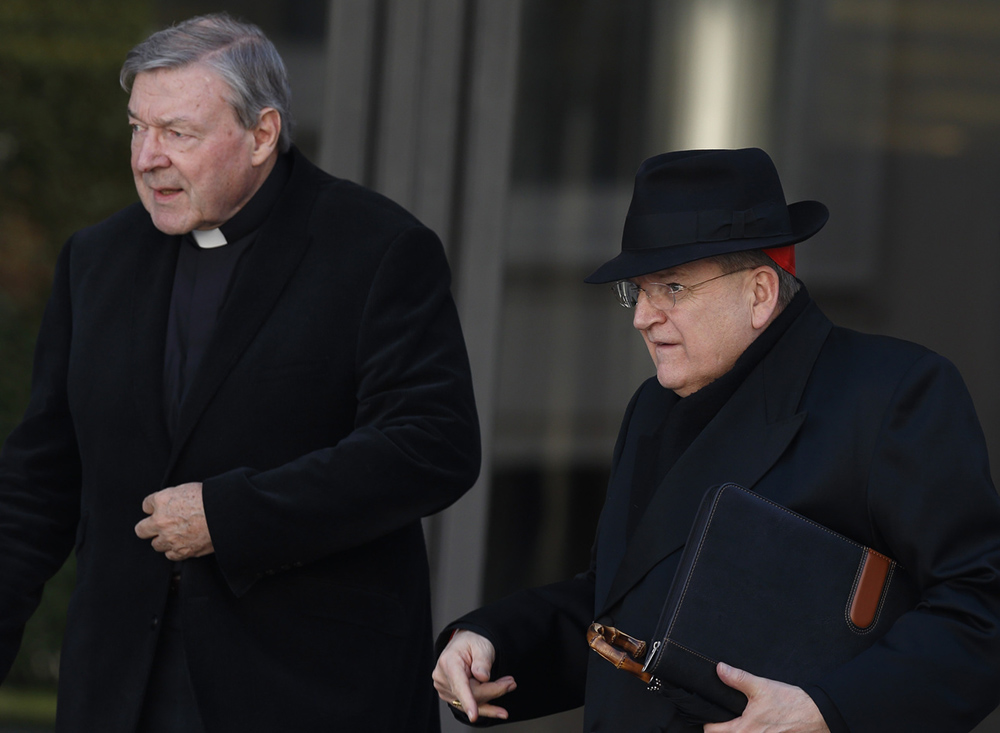
Australian Cardinal George Pell and U.S. Cardinal Raymond Burke leave a meeting of Pope Francis and cardinals in the synod hall at the Vatican Feb. 21, 2014. (CNS/Paul Haring)
"Both were clearly resistant to the whole synod process, and they were doing it in a quite public way," Lamb said. "That was the difference from other pontificates where if you were publicly opposing something the pope was trying to do, that would lead to your dismissal."
Cardinals leading the opposition
In 2016, when Francis wrote his apostolic exhortation Amoris Laetitia ("The Joy of Love"), in which the pope slightly opened the door for the divorced and remarried to receive Communion in some cases, a wide swath of the conservative English-speaking Catholic universe permanently soured on Francis, observers said.
Shortly after Amoris Laetitia, four conservative cardinals, including Burke, published a list of five questions, the so-called dubia, asking Francis to clarify what they described as ambiguities in the exhortation. Conservative Catholic websites published the dubia, which Francis never responded to.
"The dubia was not a dialogue. The cardinals wanted yes-or-no answers," Lamb said. "It was an attack on the synod process and Francis."
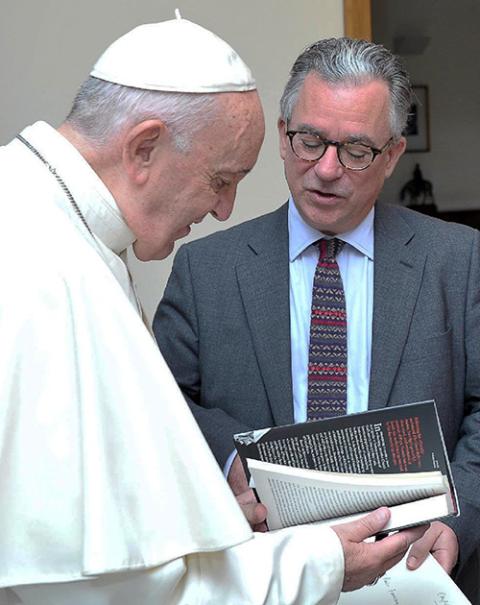
Pope Francis meets with author Austen Ivereigh in November 2019. (CNS/Vatican Media)
The dubia highlighted how Amoris Laetitia became a "point of no return" for many of Francis' conservative critics, said Austen Ivereigh, a British journalist and papal biographer who wrote about conservative resistance to Francis in his 2019 book, Wounded Shepherd: Pope Francis and His Struggle to Convert the Catholic Church.
"Amoris Laetitia tried to find a way to pastorally accompany the divorced and remarried. It doesn't undermine the doctrine of indissolubility, but even that effort raised all the conservatives' fears of surrender to modernity," said Ivereigh, who suggested that the pope attracted conservative anger by exposing a conservative ideology that masqueraded as authentic Catholicism.
"And that ideology has developed and hardened over time," Ivereigh said.
In the years since Amoris Laetitia, the conservative Catholic resistance has consistently pushed back against Francis' initiatives, criticizing everything from the Vatican's diplomacy with China to the pope's overtures to the Muslim world.
Francis' cardinal-critics — such as Burke; Pell; Gerhard Müller, the prefect emeritus of the Congregation for the Doctrine of the Faith; and, Robert Sarah, the former prefect of the Congregation for Divine Worship — became something like opposition leaders for like-minded conservative Catholics.
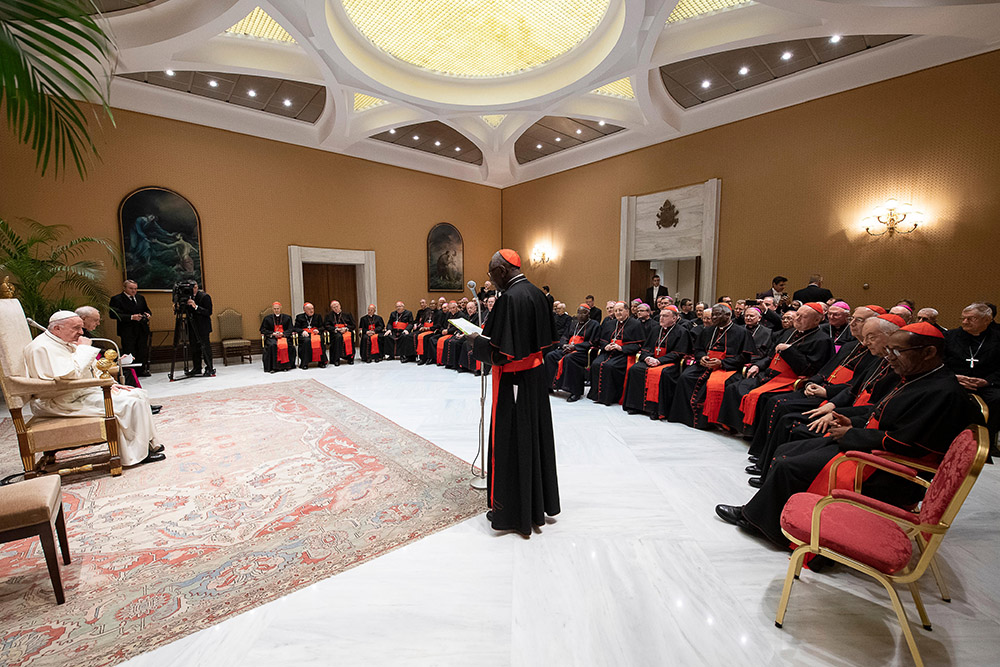
Cardinal Robert Sarah, then prefect of the Congregation for Divine Worship and the Sacraments, speaks to Pope Francis during an audience with congregation members, who were holding their plenary assembly at the Vatican Feb. 14, 2019. (CNS/Vatican Media)
"They have followers who are deeply anxious, and they've offered themselves as substitute leaders to Francis," Ivereigh said.
The Synods of Bishops that Francis convened in Rome also drew conservative ire, including the 2019 synod for the nine-nation Amazon region, where the predominant storyline in conservative Catholic media focused on wooden statues of pregnant women that Indigenous participants presented to Francis as a representation of "Our Lady of the Amazon."
The outlets falsely claimed the statues were a representation of "Pachamama," an Incan goddess from the Andes.
More recently, conservative Catholic media outlets, including EWTN, have spotlighted papal critics who warn that the 2021-23 Synod of Bishops on synodality represents "a hostile takeover" of the Catholic Church.
"Early on, I was a little stunned at the level of resistance, in part because I was under the impression that our more conservative sisters and brothers within the church had a higher view of papal authority than other Catholics," said Flores.
She added that she was "disabused of that pretense" as time went on.
"The arguments that we must obey papal authority in every and all cases, those were thin arguments and perhaps not the crux of what the matter really was in the more contentious cultural war issues within the church," Flores said.
Fraught relations with US bishops
Over the past 10 years, Francis' relations with U.S. bishops have also appeared fraught at times.
"Francis' relationship with [the U.S. bishops] hasn't recovered from that most shocking moment, Viganò's letter. It's been an uneasy relationship since then," Faggioli said, referencing an August 2018 "testimony" released by Archbishop Carlo Viganò, the Vatican's former ambassador to the U.S.
In that document, which was released in coordination with the EWTN-owned National Catholic Register and the far-right outlet Lifesite News, Viganò accused Francis of ignoring prior restrictions on former Cardinal Theodore McCarrick, a retired archbishop of Washington who has now been laicized and criminally charged in connection with a number of sexual abuse allegations.
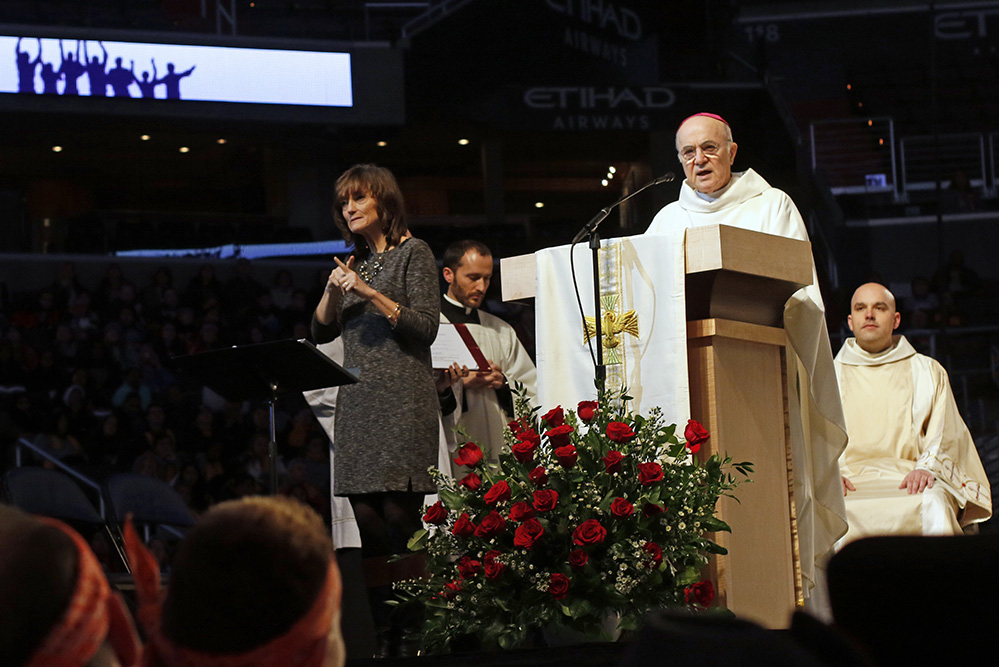
Archbishop Carlo Maria Viganò, then apostolic nuncio to the United States, delivers a message from Pope Francis at the beginning of a pro-life youth Mass at the Verizon Center in Washington Jan. 22, 2016. (CNS/Long Island Catholic/Gregory A. Shemitz)
Viganò called on the pope to resign, and several U.S. bishops issued statements vouching for the former ambassador's personal integrity. None of those bishops — including Oklahoma City Archbishop Paul Coakley, the current secretary of the U.S. Conference of Catholic Bishops — has publicly retracted his support, even though there has been no evidence to support Viganò's claims. The former ambassador has since descended into issuing conspiratorial manifestos linking COVID-19 vaccines with global elites' ambitions for a one-world government.
Asked about Viganò's letter aboard the papal plane returning from his trip to Ireland, Francis told journalists to investigate the former nuncio's accusations and come to their own conclusions. The pope's deft handling of the matter was consistent with his approach to the conservative criticisms, observers said.
"I don't think the personal criticism has that much of an impact on him," said Lamb. "I think he gets upset with it when it hurts the church." Lamb noted Francis' 2021 remarks to a group of Jesuits in Slovakia in which he seemed to reference EWTN when he said that "a large Catholic television channel" was doing "the work of the devil" and hurting the church with its attacks on the pope.
Observers said Francis has also shown a willingness to take strong action against the opposition when he believes it is necessary for the church. In July 2021, the pope issued his apostolic letter Traditionis Custodes ("Guardians of the Tradition"), which curtailed use of the Latin Mass amid the pope's concerns that the pre-Vatican-II liturgy was fostering division in the church.

A priest elevates the Eucharist during a traditional Tridentine Mass in Latin July 18, 2021, at St. Josaphat Church in the Queens borough of New York City. (CNS/Gregory A. Shemitz)
"I think he's been pastoral but yet firm and prophetic," Flores said. "I think that's been the correct tone to set within the church at this moment."
Francis' conservative opposition, with its well-financed media megaphone, has also prompted the pope to move judiciously with some of his reforms to church life and governance.
"On the whole LGBTQ issue, on the appointment of women, he goes for a step-by-step approach," Lamb said. "I think he likes that approach; he thinks that works well. He also knows if he were to go for a big reform, he knows it could unravel, so he has to be cautious and careful."
Whether or not the conservative opposition outlives Francis, who turned 86 in December, remains to be seen. Some observers believe precedents have been set and structures established that could present challenges to whoever emerges in the white cassock at the next conclave.
"This could be the beginning of a new normal," Faggioli said, "because I don't see the next pope being able to satisfy certain kinds of American Catholics in the same way they were satisfied by John Paul II and Pope Benedict between 1978 and 2013. That window historically is closed."

